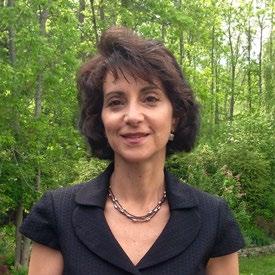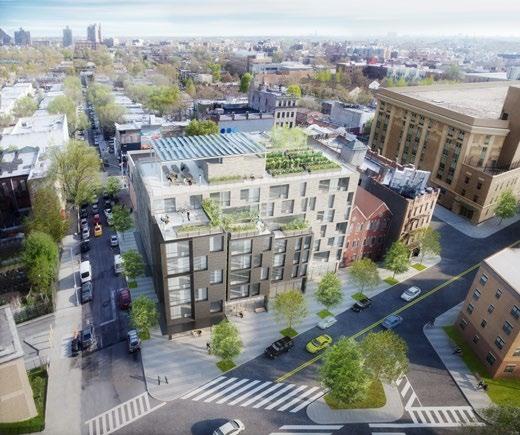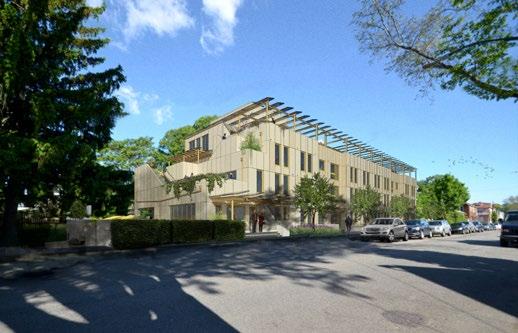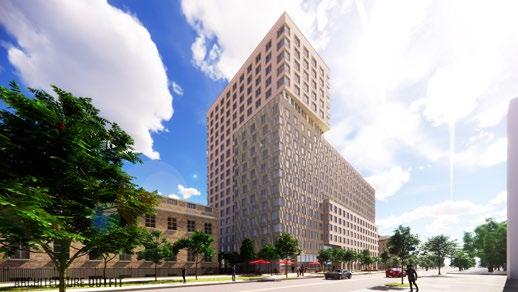
8 minute read
Advancing Carbon Neutrality Block By Block, Community By Community
1
ADVANCING CARBON NEUTRALITY BLOCK BY BLOCK, COMMUNITY BY COMMUNITY
by Janet Joseph, Senior Vice President for Strategy and Market Development, New York State Energy Research and Development Authority (NYSERDA)
New York State has the most aggressive clean energy and climate agenda in the nation as outlined in the Climate Leadership and Community Protection Act – setting a goal to reduce greenhouse gas emissions 85 percent by 2050 and putting New York State on a path to economy-wide carbon neutrality. These goals are science-based and point to the level of greenhouse gas emission reduction that we need - not just in New York State - but across the country and globally, to preserve and protect our planet and our communities.
With buildings responsible for one third of the economy-wide greenhouse gas emissions in New York State, it’s clear that we need to undertake bold action to decarbonize the State’s buildings block by block and community by community, as well as ensure that any new construction is meeting a higher standard of performance.
In conjunction with a team of national experts and stakeholders, NYSERDA has mapped out its comprehensive decarbonization strategy, in the form of the Carbon Neutral Buildings
Roadmap (https://www.nyserda.ny.gov/All-Programs/Programs/
Carbon-Neutral-Buildings), to be published later this year. The
Roadmap presents building solution sets and policy recommendations in an effort to accelerate decarbonization progress in an equitable, effective and efficient manner. The Roadmap currently presents pathways for single family homes, multifamily residences, commercial buildings, and higher education projects. It will be updated every two to three years to ensure that the research is cutting edge, the market is up to date, and the policy recommendations are relevant. Architects and other members of the design community are some of the key influencers in producing designs in a responsible way, that will push innovations to the built environments. NYSERDA partnered with AIA through the first-of-its kind, $40 million Buildings of Excellence Competition (https:// www.nyserda.ny.gov/all-programs/programs/multifamily-buildings-of-excellence) to spur the design of very low or zero carbon emitting multifamily buildings, while protecting the health, safety, and welfare of the public. Through this effort, architects and developers are working together to help shape the future of our buildings in this market sector, which represents about 40 percent of projected new building construction in New York (by square footage). Since the launch in 2019, two rounds of the Competition have awarded over $31 million to over 40 projects across both the market rate and affordable housing communities. 68 percent of the Round One and 78 percent of the Round Two funding served the low-to-moderate income community. The Competition shows the advancing shift to carbon neutrality in the New York State building stock among leaders in the architectural and design community. All 14 projects awarded in Round Two of the Competition are slated to be all-electric buildings, including the first proposed “super tall” project. The upcoming third round will build off the successes in Rounds One and Two. We remain encouraged by the innovation, interest, and participation in this Competition. The awarded projects contin-
ue to show that, with leadership and creativity, we can bring affordable, beautiful, and comfortable low carbon buildings to scale. New to Round Two of the Competition, NYSERDA partnered with The Architectural League of New York to ensure overall design quality was an important criterion in the evaluation of the projects. This effort brought together five accomplished jurors, including AIANYS President Illya Azaroff, FAIA, to evaluate the project submissions and identify those that most effectively met multiple criteria for design excellence. Five projects were selected to receive the Blue Ribbon for Design Excellence award (https://www.nyserda.ny.gov/All-Programs/ Programs/Multifamily-Buildings-of-Excellence/Winners). These projects exhibited a series of successful decisions on material, structural system, and construction technology selections, building design function, site context, and ways to make the spaces comfortable and pleasing for the occupants. The three projects highlighted below, also seamlessly integrated the building’s energy efficiency and production, resiliency, and long-term maintenance and operation into the overall design.

The Rise | Rendering by Nightnurse Images courtesy of Magnusson Architecture and Planning
The Rise, which received a $1,000,000 award, is a fully electric, mixed-use building with supportive and affordable housing units for justice-involved families. The resulting design prioritized attributes that achieve a “trauma-informed design” that focus on the safety, wellbeing, and healing of the residents. Designed by Magnusson Architecture and Planning, PC, the project successfully takes overall form and massing cues from its complex site located in the Brownsville neighborhood in Brooklyn, New York. The development was designed to Passive House and Enterprise Green Standards and is part of the Vital Brooklyn Initiative. Features include state-of-the-art heat pump water heaters for domestic hot water (DHW), variable refrigerant flow (VRF) heat pumps for heating and cooling, energy recovery ventilators (ERV), solar photovoltaic (PV) system for on-site energy generation, smart building monitoring, rooftop gardens, a greenhouse, and green roofs. The Rise will

Bethany Terraces Senior Houses | Rendering by Paul A. Castrucci, Architects PLLC
Another example of how awarded projects are advancing a low carbon and resilient future, is the all-electric, affordable housing project, Bethany Terraces. Designed by Paul A. Castrucci, Architect PLLC, the project responded to the existing site in Brooklyn, New York by creating an appropriately scaled building using prefabricated, modular design. Harnessing the benefits of modular construction, the project will be economical to construct and replicable throughout New York State. The project was designed to Passive House and Enterprise Green Standards and will be a model for the Passive House + Renewables approach to Net Zero Capable buildings. Bethany Terraces was awarded $810,840 in funding for utilizing air source heat pump (ASHP) water heaters for DHW linked with water source heat pump, VRF ASHP, ERVs, solar PV system for on-site energy generation, and smart building monitoring. The 58 units will provide a healthy and comfortable interior environment with connections to exterior gardens.

Cooper Park Commons - Building 2 | Renderings by Architecture Outfit and Magnusson Architecture and Planning
A final leading example of minimizing carbon emissions in a building, is the fully electrified, affordable housing project of Cooper Park Commons Building 2, which was awarded
continued on page 8
$1,000,000 in funding. This project is part of a multi-building development in the East Williamsburg neighborhood in Brooklyn, New York. An acknowledgment of the adjacent historic building fabric can be seen in the façade, helping to integrate the project into the context of the site. Co-designed by Magnusson Architecture and Planning, PC and Architecture Outfit, the building provides enhanced indoor air quality, comfort, health, and resiliency for all 311 housing units. The project features VRF ASHP, solar PV system for on-site energy generation, and electric appliances. The design team is committed to achieving LEED for Homes v4 Gold and Passive House Classic certifications. These standards provide top-tier maintenance and operation strategies to maximize long term operating expense savings. The project will act as a model for enhancing sustainability at other community-driven, campusstyle developments. For AIA and its members, the Buildings of Excellence Competition fits into the mission of the AIA 2030 Commitment. The Commitment goal is to transform the practice of architecture in a way that is holistic, firm-wide, project based, and data driven. AIA provides tools to assist its members in making continued progress in achieving energy efficiency in their respective project portfolios. Through this initiative, AIA continues to prioritize greenhouse gas reductions, resiliency, and occupant indoor health and comfort. We are excited to continue this partnership and advance our shared goals toward carbon neutrality in New York State’s building sector. The collective power of the architectural, development, and construction communities under the Buildings of Excellence Competition is a groundbreaking blueprint for the cost-effective transformation to creating the State’s carbon-neutral building stock. This also means investing in how to make our buildings more sustainable, with on-site renewable power sources that will help ensure that the structures are more resilient to the effects of storms and how to provide cleaner air quality for the living and working spaces of all New Yorkers. Decarbonizing buildings can be challenging, but we are accelerating toward a clean energy future through these groundbreaking and replicable designs that are reducing carbon emissions, while providing a comfortable space of residents and improving quality of life. We will continue to view these changes through an equity lens to ensure that all New Yorkers have access to the benefits of clean energy investments and low carbon housing. l Janet Joseph is the Senior Vice President for Strategy and Market Development at the New York State Energy Research and Development Authority (NYSERDA). She leads NYSERDA’s work in building decarbonization, advancing programs and policies to deliver a carbon-neutral building stock. Ms. Joseph has been working on clean energy and climate change for more than three decades. She has held technical, policy and leadership positions at NYSERDA, where she has spearheaded initiatives in green buildings, solar and renewable power, cleantech incubators, energy storage, and greenhouse gas reduction strategies that provide benefits for New Yorkers. Prior to joining NYSERDA, Janet was a research scientist at Battelle Pacific Northwest Laboratory and a consultant for Booz-Allen and Hamilton in Washington, D.C. Ms. Joseph serves on the Boards of the Northeast Energy Efficiency Partnerships, Urban Green, New York State Center for Future Energy Systems, and the Urban Futures Lab. Janet received the 2015 Public Service Excellence Award from the State Academy for Public Administration, and was voted as one of the top ten Clean Tech leaders in New York. She has a Master’s degree in Environmental Chemistry from the University of Maryland, where she did research on the impacts of coal combustion on the environment.






